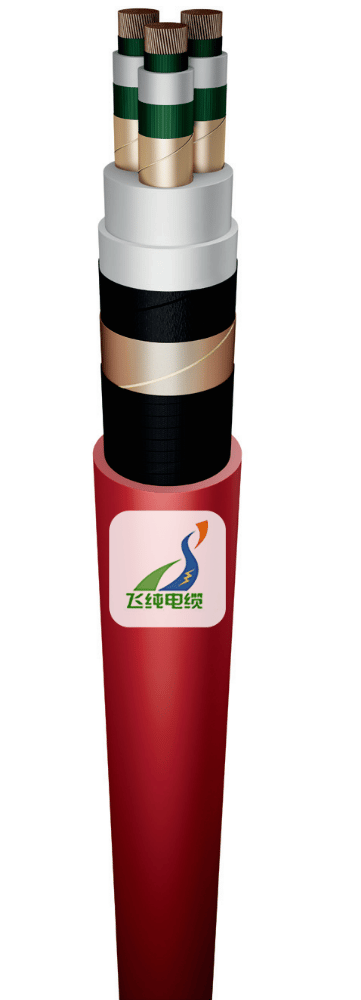Type YUHKGXSekyn 3.6/6 kV mining cables
Mining power cable with individual shield and copper core,
XLPE insulation, PVC sheath, overall shield,
with longitudinal seal, flame retardant PVC outer shell


Type YUHKGXSekyn 3.6/6 kV mining cable:
Purpose:
Designed for underground mining power networks with a nominal voltage up to 6 kV.
Suitable for hazardous areas—both methane and non-methane zones—including environments with potential coal dust explosions.Standard & Certification:
Manufactured according to the ZN-TF 203:2006 standard and certified by bodies such as EMAG and WUG.
RoHS compliant.
Cable Construction
Conductors:
Made of multi-stranded, round copper wires (Class 2 as per EN 60228).
Provides efficient electrical conduction.
Individual Shielding:
Each copper conductor is wrapped with its own screen.
The screen can be made using a conductive tape (or conductive polyethylene) combined with copper tape.
Insulation:
Uses cross-linked polyethylene (XLPE) insulation (Type DIX 3 as per PN-HD 620 S1:2002).
Offers high electrical resistance and durability.
Inner Sheath (Powłoka wewnętrzna):
Made from PVC (Type DMV 31) protecting the insulation.
Overall Shield:
A layer of copper tape is wrapped around the entire cable for extra protection.
Longitudinal Sealing:
A water-activated (swelling) tape is applied along the cable’s length to prevent moisture ingress.
Outer Jacket (Osłona zewnętrzna):
Made of flame-retardant PVC (tire-type PVC) that limits flame spread in case of fire.
Key Characteristics
Temperature Ratings:
Normal Operation: Conductor temperature up to +90°C.
Fault Condition: Can withstand up to +250°C.
Ambient Temperatures:
Permanent installations: as low as –30°C.
When laying cables without preheating: as low as –50°C.
Mechanical Properties:
Minimum Bending Radius: 12 times the external diameter of the cable.
Test Voltage: Withstands 15 kV AC (applied for 5 minutes at 50 Hz).
Tensile Strength: Maximum pulling force is 50 times the total cross-sectional area of the conductors.
Flame Propagation Resistance:
Meets IEC 60332 standards, ensuring the cable does not support the spread of flames.
Applications
Mining Environments:
Ideal for use in underground mines with a nominal voltage up to 6 kV.
Suitable for both methane and non-methane zones, including areas classified with explosion risks (Classes A or B) for methane or coal dust.
Electrical & Mechanical Data
Cable Variants:
Available in sizes ranging from 3x25/25 mm² up to 3x240/30 mm².
(For example, “3x25/25” means three conductors, each with a nominal cross-section of 25 mm², with a 25 mm² overall configuration.)
Tables Provided Include:
Dimensions: Nominal thicknesses for insulation, inner sheath, and overall shield.
Cable Diameter & Weight: Approximate external diameter and weight per kilometer.
Conductor Resistance: Maximum resistance at 20°C.
Current-Carrying Capacity: Rated for an ambient temperature of +25°C.
Electrical Parameters: Unit inductance and reactance (measured per km).
Installation Considerations:
Cable Grouping:
When cables are laid parallel or stacked on supports, the current-carrying capacity must be adjusted using correction factors:1 cable: 1.00
2 cables: 0.93
3 cables: 0.90
6 cables: 0.87
9 cables: 0.86
Ambient Temperature Correction (Kt):
For temperatures above +25°C, additional factors are applied (e.g., at 30°C the factor is 0.96, at 35°C it’s 0.92, etc.).
Packaging
Standard packaging options include 500 or 1000-meter drums.
Custom lengths and packaging types can be arranged if needed.

Frequently Asked Questions (FAQ)
Q: What is the primary application of the Type YUHKGXSekyn cable?
A: It is specifically designed for underground mining power networks with a nominal voltage up to 6 kV, particularly in hazardous zones such as methane and coal dust environments.
Q: What voltage ratings does this cable support?
A: The cable is rated for 3.6/6 kV operations, making it suitable for medium-voltage mining installations.
Q: What type of conductor is used in this cable?
A: It uses multi-stranded, round copper conductors that meet Class 2 standards as per EN 60228, ensuring excellent electrical conductivity.
Q: How is individual shielding implemented in the cable?
A: Each conductor is wrapped with its own shield, which can be made from conductive tape or conductive polyethylene combined with copper tape, minimizing interference.
Q: What additional shielding does the cable feature?
A: In addition to individual shields, an overall copper tape shield is applied around the cable for enhanced protection against external electrical disturbances.
Q: What insulation material is used, and why is it beneficial?
A: The cable uses cross-linked polyethylene (XLPE) insulation, which offers high thermal stability, excellent electrical properties, and mechanical strength.
Q: How does the cable prevent moisture ingress?
A: A longitudinal sealing tape that swells when exposed to water is applied along the cable, ensuring effective moisture protection.
Q: What materials are used for the inner and outer sheaths?
A: The inner sheath is made from PVC (Type DMV 31), and the outer jacket is a flame-retardant, tire-type PVC that minimizes flame spread.
Q: Which standards does the cable comply with?
A: It meets the ZN-TF 203:2006 standard and complies with relevant IEC standards for flame retardancy and performance.
Q: Is the cable suitable for use in hazardous mining environments?
A: Yes, it is approved for hazardous areas, including methane and coal dust explosion risk zones, ensuring safe operation in challenging conditions.Q: What is the maximum operating temperature of the conductor during normal conditions?
A: The conductor can safely operate at temperatures up to +90°C under normal conditions.
Q: How does the cable perform under short-circuit conditions?
A: During short-circuit events, the conductor temperature may reach up to +250°C, demonstrating its robustness in fault conditions.
Q: What are the minimum ambient temperature requirements for installation?
A: For permanent installations, the cable can be laid at ambient temperatures as low as –30°C, and down to –50°C when laid without preheating.
Q: What is the recommended minimum bending radius?
A: The cable should not be bent tighter than 12 times its external diameter, ensuring the internal components are not stressed.
Q: What high-voltage test does the cable undergo?
A: The cable is tested at 15 kV AC for 5 minutes at 50 Hz to verify its insulation integrity and overall performance.
Q: How is the cable’s tensile strength defined?
A: The maximum pulling force is rated at 50 times the sum of the conductors’ cross-sectional areas, ensuring it can withstand the rigors of mining installations.
Q: How does the outer PVC jacket enhance safety?
A: The flame-retardant PVC outer jacket is designed to inhibit flame propagation, crucial for maintaining safety in explosive atmospheres.
Q: What range of conductor sizes is available?
A: Conductor sizes vary from 3x25/25 mm² to 3x240/30 mm², offering flexibility for different current-carrying requirements.
Q: Are custom packaging options available for this cable?
A: Yes, while standard packaging is available in 500 or 1000-meter drums, custom lengths and packaging options can be arranged as needed.
Q: What is the purpose of the individual shielding on each conductor?
A: Individual shielding minimizes electromagnetic interference and enhances operational safety, particularly in electrically noisy mining environments.
Q: What is the function of the overall copper tape shield?
A: The overall shield provides an extra layer of protection against external disturbances and further secures the cable’s electrical performance.
Q: How is the cable’s current-carrying capacity affected by ambient temperature?
A: The cable’s current-carrying capacity is derated for ambient temperatures above +25°C using specific correction factors (Kt).
Q: What correction factors apply when multiple cables are installed together?
A: When cables are laid in parallel or stacked, correction factors (Kg) are used—for instance, 1.00 for one cable, 0.93 for two, 0.90 for three, and so on.
Q: How does the cable perform in high humidity or wet conditions?
A: The combination of robust insulation, moisture-resistant sheathing, and longitudinal sealing ensures reliable performance even in high humidity or wet environments.
Q: Is the cable RoHS compliant?
A: Yes, it is RoHS compliant, which means it meets the necessary environmental standards regarding hazardous substances.
Q: What are the cable’s typical electrical parameters such as inductance and reactance?
A: For example, a 25 mm² conductor typically has a unit inductance of 0.32 mH/km and a reactance of 0.101 Ω/km, although these values vary with conductor size.
Q: Why is XLPE insulation preferred for mining cables?
A: XLPE provides excellent thermal, mechanical, and electrical performance, making it ideal for the demanding conditions in mining operations.
Q: How does the cable ensure safety in explosion-prone environments?
A: Its flame-retardant outer sheath, combined with robust construction and proper shielding, minimizes the risk of fire and explosion in hazardous atmospheres.
Q: What details are available regarding the cable’s physical dimensions and weight?
A: The cable’s overall diameter, weight per kilometer, and insulation thickness vary depending on the selected conductor size, with detailed specifications provided in technical tables.
Q: What certifications support the cable’s performance claims?
A: The cable is certified by recognized organizations such as EMAG and WUG, ensuring it meets stringent safety and performance standards.
Q: Can this cable be used in both methane and non-methane mining areas?
A: Yes, it is designed for safe operation in both methane and non-methane zones, accommodating various explosion risk classifications.
Q: What kind of testing does the cable undergo before shipment?
A: The cable undergoes rigorous testing including high-voltage endurance, mechanical stress tests, and conformity checks with international standards.
Q: What maintenance practices are recommended for this cable in mining installations?
A: Regular visual inspections, adherence to installation guidelines, and periodic testing of insulation and shielding integrity will help ensure long-term reliability.






Type YUHKGXSekyn 3.6/6 kV mining cable
Type YUHKGXSekyn 3.6/6 kV mining cable is designed for reliable power distribution in harsh underground mining environments. It features multi-stranded copper conductors, each with its own individual shield, combined with robust XLPE insulation and a flame-retardant PVC outer jacket. An overall copper tape shield and a water-activated longitudinal seal provide additional protection against electrical interference and moisture. Certified to meet strict industry standards and suitable for both methane and non-methane areas, this cable delivers excellent electrical performance and durability in extreme conditions.
6/30/20216 min read
